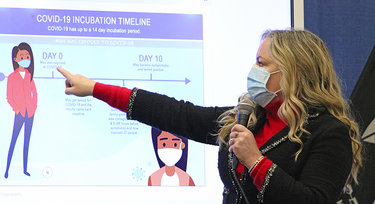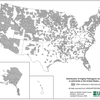Record-breaking number of county residents are quarantined: 3,317
ALBANY COUNTY — For the seventh day in a row, Albany County Executive Daniel McCoy had the sad task Tuesday morning of announcing more COVID-19 deaths.
A woman in her seventies and a man in his sixties died of the disease, bringing the county’s death toll to 183.
For two weeks in a row, the county’s daily rate of new infections has been in the triple digits. On Tuesday, McCoy announced 178 new positive test results.
Also, more county residents than ever before are under mandatory quarantine — 3,317. The county had broken the 3,000 mark on Sunday, which McCoy called “another record we weren’t happy to hit.”
He said of the county’s health commissioner, Elizabesth Whalen, “Dr. Whalen has called on our Medical Corps” — a reference to volunteers, often retired doctors or nurses, who help the health department.
“We’re putting more tracers and people into play, assigning more people to the health department,” said McCoy. “It’s overwhelming … Bear with us. It’s a lot of people to deal with.”
Whalen reiterated that residents, while they wait to hear from health-department staff, can consult the department’s website for guidance on isolation if they have tested positive for COVID-19 and on quarantine if they have been exposed to someone with the disease.
She also pointed to an online graphic to illustrate how someone can unwittingly spread the disease — a topic on which some confusion remains, she said.
In the illustration, a woman is exposed to COVID-19 on Day 0, tests negative on Day 5, then goes to work and to a family gathering on Day 8, unwittingly exposing 22 people, before testing positive on Day 10.
“This is why COVID is tricky,” said Whalen.
What the data shows
Governor Andrew Cuomo earlier this week pointed to state data that showed 74 percent of COVID-19 cases are now caused by “living-room spread,” small in-home gatherings where people often don’t wear masks and don’t stay six feet from one another.
“It’s gonna get tough before it gets better,” said McCoy.
He pointed to a bar graph showing that the 20-to-29 age group still has the most infections in Albany County but the 30-to-39 age group is catching up, currently with 1,125 cases, and the 10-to-19 age group is also climbing.
Kids in this group, McCoy said, often show no signs or symptoms and can inadvertently spread the disease to their parents or grandparents.
McCoy also noted a shift in the age of people dying from COVID-19. Those dying in the 50-to-74 age group in Albany County is increasing (from 24 percent on Oct. 28 to 28 percent now) while those dying over the age of 75 is decreasing (from 74 percent on Oct. 28 to 70 percent now).
“Not only have we entered a second surge,” said Whalen, pointing to a graph that showed the current cases towering over the former springtime apex. “But we are really experiencing growth beyond what we saw the first time.”
The first surge was controlled by a statewide shutdown. The state is currently using a micro-cluster approach, applying restrictions to areas with high rates of infection and limited hospital capacity.
Whalen has said the county has dealt with “micro-micro-clusters,” very small outbreaks.
Her health department has recommended, for example, a two-week closure for businesses that have experienced a cluster “in particular if we see sustained transmission.”
Businesses have cooperated with the suggestion, she said, and so far there has been no formal legal enforcement.
“As our cases continue to grow,” said Whalen, “we are concerned that hospitalizations will continue to grow and what we don’t want to do is overwhelm the system.”
Vaccine
New York State and Albany County administered the first vaccinations for COVID-19 on Monday.
“It’s very heartening to know we have a vaccine,” said Whalen on Tuesday.
Counties have participated in conference calls with the Centers for Disease Control and Prevention, she said, to learn about the vaccine now being deployed from Pfizer and BioNTech. It is being given to frontline workers and to residents and workers at nursing homes.
The vaccine is given in two doses, 21 days apart, and usually takes a week to two weeks before full inoculation is achieved, said Whalen.
A second vaccine, from Moderna, is expected to follow.
The Pfizer vaccine has been shown to be 95 percent effective, said Whalen.
“We know that it is safe. We know that it is our most important tool so far to stop this pandemic,” she said.
Albany County has planned for more than 10 or 15 years, Whalen said, to administer vaccinations in the event of a pandemic.
“We stand ready to partner with the federal government in the deployment of this vaccine ...,” she said. “However, it is important for the public to know this is not an imminent option for members of the public. It will likely be months before this is rolled out to the general public.”
She again urged people not to participate in the usual holiday gatherings. “That sacrifice … could save lives,” Whalen concluded.
Newest numbers
As of Tuesday morning, Albany County has 8,120 confirmed cases of COVID-19, McCoy announced.
Of the 178 new cases, 17 had close contact with someone infected with the disease, 156 did not have a clear source of infection identified at this time, and five are health-care workers or residents of congregate settings.
The five-day average for new daily positives decreased to 176 from 182. There are now 1,691 active cases in the county, up from 1,639 on Monday.
The number of people under mandatory quarantine increased to 3,317 from 3,244. So far, 28,541 people have completed quarantine. Of those, 6,429 had tested positive and recovered.
There were 16 new hospitalizations reported overnight, and there are 94 county residents currently hospitalized from the virus – a net increase of eight. There are now 15 patients under intensive, up from 13 yesterday.
Statewide, according to a release from the governor’s office, the positivity rate, based on Monday’s test results is 5.33 percent.
The Capital Region, of which Albany County is a part, had a rate of 6.17 percent. The Finger Lakes continue to have the highest rate of the state’s 10 regions, at 8.17 percent, and the Southern Tier has the lowest rate, at 2.23 percent.
The Capital Region has 288 patients hospitalized with COVID-19, which is 0.03 percent of the population and leaves 25 percent of hospital beds available. Statewide, 0.03 percent of New Yorkers are hospitalized with COVID-19 and 23 percent of hospital beds are available.
The Capital Region has 266 ICU beds with 167 currently occupied by COVId-19 patients, leaving 40 percent available. Statewide, 33 percent of ICU beds are available.


